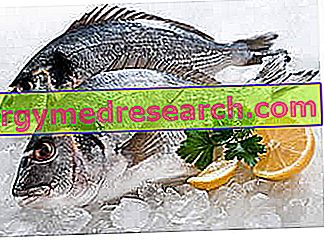Generality
The sea bream is a bony sea fish belonging to the family Sparidae, Genus Sparus, Species aurata ; the binomial nomenclature is Sparus aurata L.

The body of the gilthead is covered with silver scales, tending to gray on the back and whitish on the belly. The fins are the same color as the body and, at times, the dorsal (with spiny and soft rays) and the caudal fins have a typical black border. The pectoral, ventral and anal fins are normally developed.
The sea bream can reach considerable dimensions (up to 7-8 kg in weight) but the commercial size includes the capture and distribution of very young specimens; the average size of the breeding sea bream (carried out in intensive fish farming or extensive fish farming) is about 350g of weight for 20-40cm of length (about 2-3 years of life).
The sea bream is a proterandrous hermaphrodite fish (from proterandria ), that is that it is born univocally endowed with male gonads, which are inverted to female ONLY reaching a certain size; also for this reason it would be fundamental that the sampling of the wild bream took place in a selective manner, retaining only specimens weighing more than 400-500g (thus giving the sparide the possibility of performing at least one or two reproductive cycles). However, this important concept seems unknown (mostly ignored) to both professional fishermen and "sporting" anglers. Among the latter - having the possibility to carry out the release - those who do not carry out a selection fishery and take a large number of specimens (in concomitance with the migratory exodus in the lagoon) show little respect for the sea and the environment.
Habits and spreading of sea bream
The sea bream is a species present both in the Mediterranean basin and in the Atlantic Ocean (European side - from England to half of the African continent); it has coastal habits but it is not uncommon to run into large herds even in the open sea, near the hats of shoals (even deep ones) or on manufacturing architectural structures (eg methane extraction platforms or wrecks). As anticipated, the sea bream makes significant shifts for reproduction and, despite being a saltwater fish, it tolerates in an exceptional way (as much as the sea bass) the brackish water near lagoons and river mouths. It feeds mainly on invertebrates (molluscs, crustaceans, worms and annelids) and completes the reproductive cycle in the late autumn period.
Gastronomy and nutritional characteristics of bream
Sea bream is one of the most widespread and valuable fishery products of the Mediterranean Sea; in Italy it represents - together with sea bass, grouper, tuna, swordfish and snapper - the most appreciated and consumed fish. Being easily bred, the gilthead enjoys a fairly affordable retail cost, although the qualitative difference between an intensively bred fish (with the use of animal meal based on pellets ) and a wild one is quite marked; a good compromise is the breeding sea bream.
In the kitchen, the gilthead lends itself to every type of preparation, but the dimensions and the origin can constitute extremely useful variables to prefer one or another culinary destination. The fresh and caught bream can be eaten: raw (carpaccio or sushi), baked (natural, baked, vegetable crust, etc.), grilled (with charcoal or wood, direct gas or stone) lava, on electric resistances), in a pan (even just the fillets), boiled or steamed (in a muffler or in a pressure cooker), carpione etc.
The larger specimens (> 2-3kg), if not prepared in foil (however quite demanding), need to be dismembered in slices or fillets, as grilling or baking would be particularly laborious.
Discover the Video Recipe - Sea Bream in salt crust, below the video preview.
Salt Fish
X Problems with video playback? Reload from YouTube Go to Video Page Go to Video Recipes Section Watch the video on youtubeThe sea bream is basically a lean fish but, as for the sea bass, it has a fairly obvious difference between the farmed fish (more fat) and the one fished (over 250% less fat); I therefore suggest that you always prefer fairly bland cooking, not too intense or prolonged, which could cause water and fat to be dehydrated / drained, which are excessively present in the meat and under the skin. Furthermore, for gourmets of "crudités", I advise you to AVOID absolutely bred fish; the food used gives an unpleasant smell to the adipose tissue, making the fish not very suitable for this kind of preparation.
Some use the gilthead also to compose stuffed pasta stuffing.
The sea bream contains a good portion of polyunsaturated fatty acids (but not in the same quantities as blue fish) and monounsaturated, while the intake of cholesterol is moderate; it therefore lends itself to the diet against overweight and to the diet for the treatment of dyslipidemia (hypercholesterolemia or hypertriglyceridemia).
The energy supply is provided mainly by high biological value proteins (with leucine limiting amino acid) and to a lesser extent by fatty acids (with a prevalence of monounsaturated or polyunsaturated depending on whether it is a breeding bream or wild).
The vitamin intake is good and favors the concentrations of niacin (vit. PP) and riboflavin (vit. B2).
Nutritional composition of the Bream - Reference values of the INRAN Food Composition Tables
Comparison Bream, wild, fresh, fillets, sea bream, farmed, fresh, fillets and sea bream, frozen

| Chemical composition and energy value of foods per 100g of edible portion | Sea bream, wild, fresh, fillets | Sea bream, farmed, fresh, fillets | Sea bream, frozen | |
| Edible part | 100.0% | 100.0% | 69, 0% | |
| water | 73.2 | 69, 1g | 78, 4g | |
| Protein | 20, 7g | 19, 7g | 19, 8g | |
| Lipids TOT | 3, 8g | 8, 4g | 1.2g | |
| B.C. saturated fats | 0, 88mg | 1, 94mg | - mg | |
| B.C. monounsaturated fats | 0, 93mg | 2, 78mg | - mg | |
| B.C. polyunsaturated fats | 1, 21mg | 2, 21mg | - mg | |
| Cholesterol | 64, 0mg | 68, 0mg | 63, 0mg | |
| TOT Carbohydrates | 1.0g | 1.2g | 1.0g | |
| Starch / Glycogen | 0.0g | 0.0g | 0.0g | |
| Soluble sugars | 1.0g | 1.2g | 1.0g | |
| Dietary fiber | 0.0g | 0.0g | 0.0g | |
| Power | 121, 0kcal | 159, 0kcal | 94, 0kcal | |
| Sodium | - mg | - mg | - mg | |
| Potassium | - mg | - mg | - mg | |
| Iron | - mg | - mg | 0.4mg | |
| Football | - mg | 30, 0mg | 12, 0mg | |
| Phosphorus | - mg | 1050, 0mg | 125, 0mg | |
| Thiamine | - mg | - mg | 0, 04mg | |
| Riboflavin | - mg | - mg | 0, 14mg | |
| Niacin | - mg | - mg | 4, 30mg | |
| Vitamin A | - µg | - µg | 0.0 µg | |
| C vitamin | - mg | - mg | 0, 0mg | |
| Vitamin E | - mg | - mg | - mg | |



